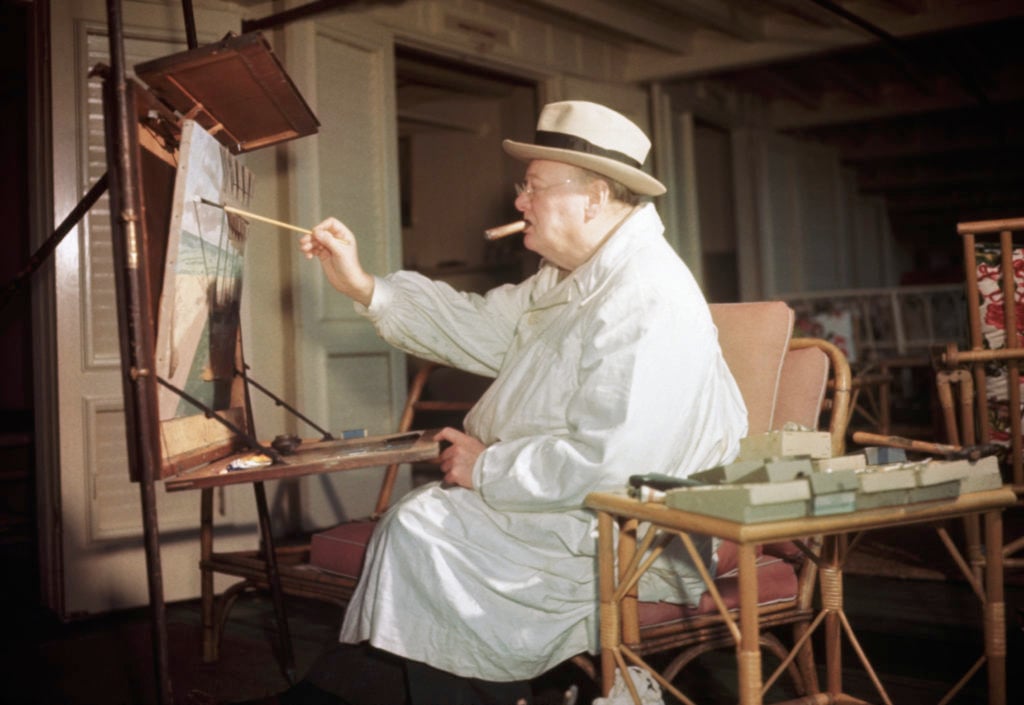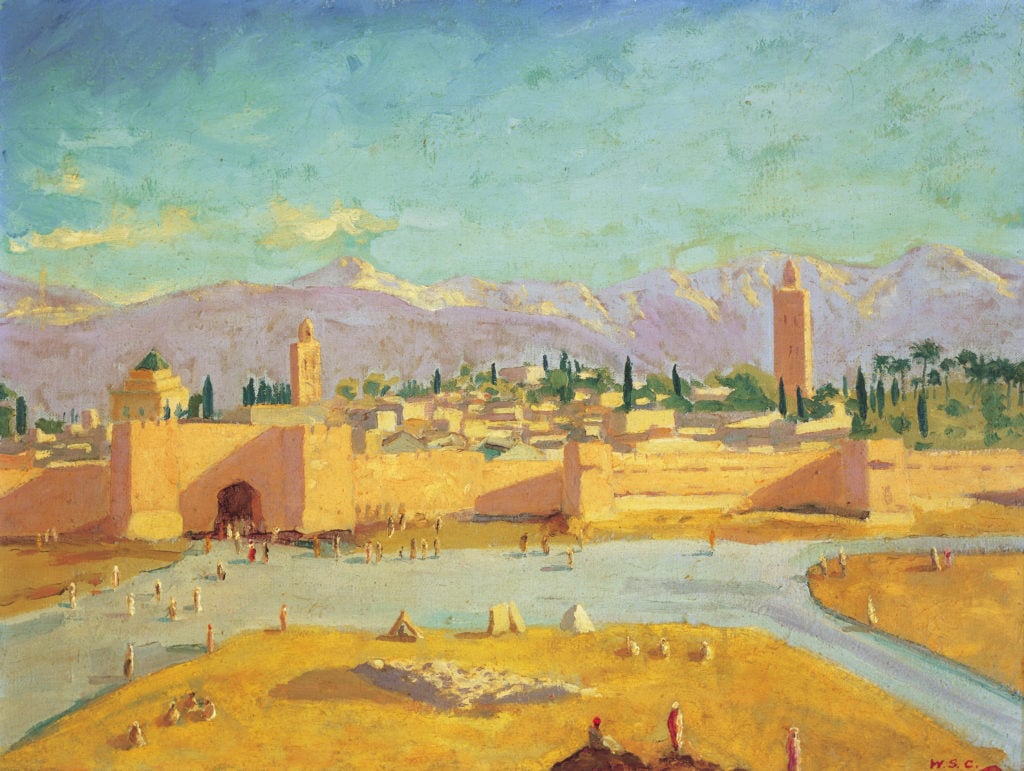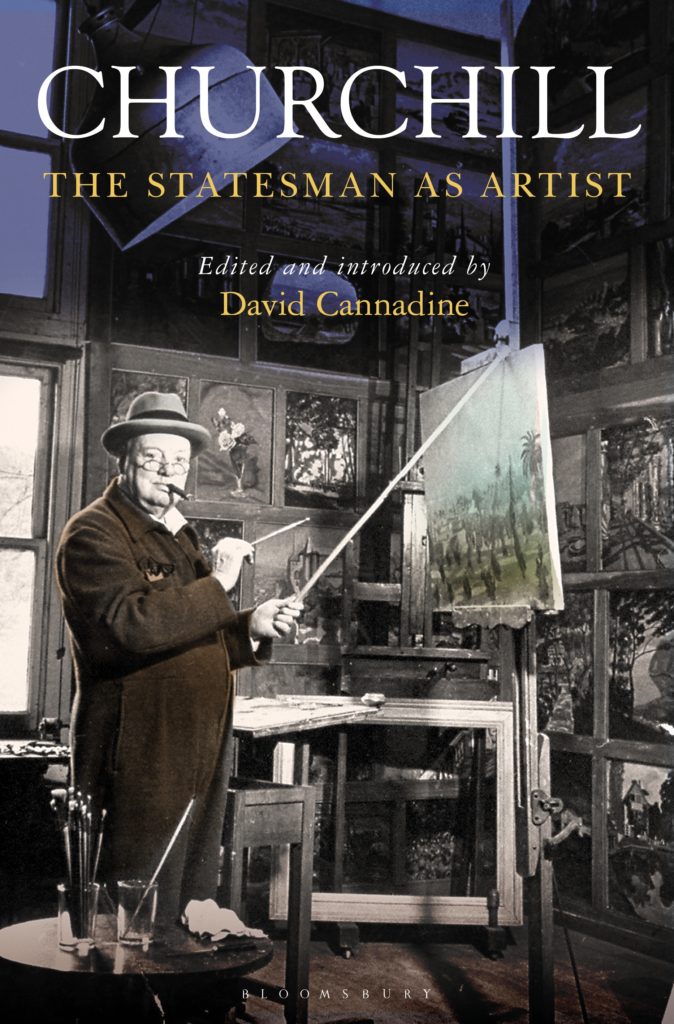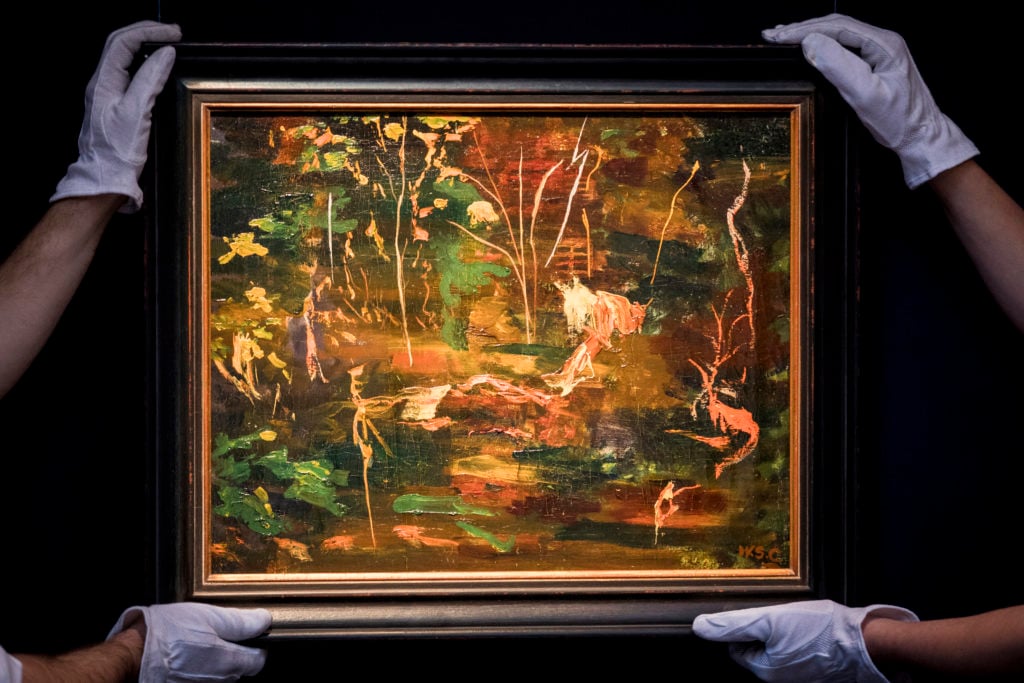Politics
‘Audacity Is the Only Ticket’: How Winston Churchill, an Amateur Artist, Treated Painting as a Battlefield


David Cannadine

During the summer of 1915, Churchill’s spirits were at their lowest ebb in the aftermath of the disastrous troop landings in the Dardanelles at Gallipoli. There were large losses of life, and the British and imperial forces were eventually compelled to withdraw. As the most ardent advocate of what became this doomed operation, Churchill bore the brunt of the blame for the fiasco, and when Asquith was forced to reconstruct his government in May 1915, Churchill was compelled to resign as First Lord of the Admiralty, and was fobbed off with the sinecure post of Chancellor of the Duchy of Lancaster. Out of power, and very soon to be out of office, he fell into a depression so severe and so protracted that Clementine feared he would die of the grief which was hauntingly depicted by William Orpen in the portrait of Churchill he completed at that time. Shunned by the political establishment, Winston and Clementine sought refuge at Hoe Farm, a small country house they rented in Surrey, where Churchill’s younger brother Jack and his wife Gwendeline (known as ‘Goonie’), often came to stay. Goonie was an accomplished water-colorist, who brought her brushes and easel with her, and on one such visit she persuaded Churchill to try his hand at painting. He was immediately captivated, and soon changed to oils as being a stronger and more robust medium than watercolors. He sent Clementine to nearby Godalming to buy him paints, and on his return to London he opened an account with Roberson’s, the artist’s suppliers in Long Acre, where he made regular purchases of paint, turpentine, canvases, easels, and other materials. Hence, too, those first visits to the National Gallery, as he sought to study and learn from the techniques of the great artists of the past.
During these early years, Churchill experimented with a wide variety of styles and subjects. One of his first efforts was a searing self-portrait, half-eclipsed in a black-dog-like shadow, and vividly conveying the depression and isolation against which he was struggling. At the end of 1915, Churchill resigned from the government, re-joined the army, and briefly commanded a battalion of the Royal Scots Fusiliers at Ploegsteert on the borders of France and Belgium. Now a painter as well as a soldier, he took his brushes and canvases with him, and early in 1916 he completed several somber pictures of the devastated buildings and war-torn countryside of Flanders. “I think,” he wrote to Clementine at this time, “that [painting] will be a great pleasure and resource to me—if I come through all right.” Churchill did, indeed, survive, his political fortunes gradually began to improve, he returned to government in 1917 as Minister of Munitions, and the Great War ended the following year. As his spirits revived, Churchill turned his artistic attention to more cheerful and optimistic subjects, increasingly concentrating on those warm, brightly-lit landscapes which banished depression rather than expressed it, and offered an escape from the pressures of public affairs. This change in his painterly priorities was vividly demonstrated in the canvases he completed in Cairo in March 1921, when as Colonial Secretary he presided at a conference which created the new nations of Iraq and Transjordan (under British control). The pictures Churchill produced of the Pyramids were sun-drenched and brightly-lit, and they were the most vivid and cheerful works he had yet completed. By this time, he had fallen in love with the Impressionists’ use of light and color, and their works, along with those of Joseph Mallord William Turner, would henceforward be his inspiration among painters of the past. As he would later put it: “light is life,” and what better antidote to the “black dog” could there be than that?

Winston Churchill’s painting from Marrakesh.
While seeking to improve as an artist, Churchill not only visited galleries to learn from the great painters of the past, but also sought advice from those who were living. The first was Sir John Lavery, who was a neighbor of Churchill’s in the Cromwell Road, where he and his family had gone to live after he had been forced to leave the Admiralty. In the autumn and winter of 1915, Churchill and Lavery often painted together in Lavery’s studio, and each produced portraits of the other working at their easels. Lavery’s wife Hazel was also an accomplished artist, and it was she who urged Churchill never to be in awe of an empty canvas; while her husband considered that had Churchill “chosen painting instead of statesmanship, I believe he would have been a great master with the brush, and as President of the Royal Academy would have given stimulus to the art world.” Churchill and Lavery became and remained close friends, as did their wives (and the Laverys also played a part in bringing Churchill and Michael Collins together when both were involved in negotiating the post-war Irish Treaty). “I have not made much headway in painting,” Churchill wrote to Lavery from Cannes in January 1923, “and should greatly have valued the stimulus of your presence and example … I have been four or five days trying to do some pretty reflections of bright-colored ships in the clear water of the harbor. I should have liked to have seen you splash them on.” Later in the same decade, Churchill was introduced to Walter Sickert, whom Clementine had known when she was a girl living with her mother in Dieppe. In 1927, Sickert renewed his acquaintance with her, and also established a brief but influential friendship with her husband. For the next two years he offered Churchill advice on how to prepare his canvases, as well as demonstrating his own techniques for the handling and laying-on of paint. Even more importantly, Sickert taught Churchill how to work from photographs, either as preliminary documents for a painting, or as aides-memoire to use in his studio when completing a landscape he had begun on-site but left unfinished on returning home. “I am really thrilled,” Winston wrote to Clementine from Chartwell in September 1927, “by the field he is opening to me. I see my way to paint far better pictures than I ever thought possible before. He is really giving me a new lease of life as a painter.” As a result of Sickert’s tutelage, Churchill also went back to painting occasional portraits, but now basing them on photographs; they would never form a major component of his artistic oeuvre, although he rendered a memorable image of Clementine using this technique as late as 1955. Like Lavery, Sickert also painted Churchill’s portrait, but neither Clementine nor Winston liked the result, on the grounds it made him look like a bookie, and after two years, the friend- ship fizzled out.
Yet Churchill seems genuinely to have relished the company of artists, not only as a welcome break from his political friendships (and antagonisms), but also for its own sake. He liked art talk and painterly conversation, several artists became lifelong friends, and he would later be deeply saddened by the deaths of Hazel Lavery and Sir William Orpen. During the inter-war years, Orpen, Lavery, Sir Alfred Munnings, and Sir William Nicholson would all be elected to the Other Club—membership of which Churchill regarded as virtually the highest form of recognition that could be bestowed on anyone, and where the conversation was animated, boisterous and uninhibited. He was also an admirer of the work of Sir Edwin Lutyens, another member of the Other Club, who would serve as President of the Royal Academy from 1938 to 1944. During the 1930s, the young Kenneth Clark, then director of the National Gallery, would also become a friend: Churchill invited him down to Chartwell, and dined regularly with him at the Clarks’ grand house at 30 Portland Place. They had further dealings throughout the Second World War, especially while Clark worked at the Ministry of Information, and they remained in touch thereafter. Clark would be one of the dinner guests at 10 Downing Street when Churchill suffered a major stroke in July 1953; he would advise Churchill on which pictures to send to the Royal Academy for display in its Summer Exhibitions; and he would recommend Graham Sutherland to paint the ill-fated portrait, commissioned by the House of Commons, to mark Churchill’s eightieth birthday.
By the time he was established at Chartwell, the Kent country house which he bought in 1922, painting had become an essential part of the settled life Churchill now craved: if the weather was good, he would depict exterior views of the house; if bad then he would paint still-lifes—fruit, flowers or bottles—inside; and he soon established his own studio in one of the out-buildings. Across more than four decades, Churchill would eventually complete some five hundred canvases—an astonishing output, given the many other calls on his time, energy and imagination. Indeed, by the inter-war years, painting had come to rank second to writing among his many non-political activities. But there were two significant differences between them. Churchill wrote for serious public purposes: to celebrate his family, to vindicate his political record, to intervene in the political issues of the day, and to make the substantial sums necessary to finance his lavish style of life. By contrast, he painted entirely for therapy and enjoyment: whereas he took pride in being a professional writer, he always regarded himself as merely an amateur artist, and while he wrote for money, he never intended to sell his “little daubs” to increase his income. Moreover, while Churchill spent most of his waking hours talking incessantly, preparing and making his speeches, delivering monologues at the lunch- and dinner-table, and dictating his journalism and his books, painting was the only activity he seems to have carried out in concentrated peace and complete silence. It absorbed him for many continuous hours, taking his mind off everything else, and off everybody else, too—which was why he found it so therapeutic. Even in his later years of fame and travel, when his expeditions with brushes and paints were accompanied by a large entourage, he would remain focused and hushed before his easel.
Although Churchill painted primarily for therapy, pleasure and relaxation, his new hobby soon became public knowledge, albeit in a minor sort of way. In January 1921, he exhibited a number of his early canvasses in the Galerie Druet in Paris, under the pseudonym of Charles Morin, where four of the five landscapes on display were bought for £30 each. Four years later, he won an amateur art competition held at Sunderland House in London, where the judges were the painter Sir Oswald Birley, the dealer Joseph Duveen and Kenneth Clark. Seeing the journalistic possibilities, Churchill also set down his thoughts on painting in two articles which appeared in the Strand magazine, published in December 1921 and January 1922. Clementine, who was often more concerned about her husband’s reputation than he was himself, feared that such ‘naif or conceited’ pieces, by someone who had never been trained to paint, might “vex” the artistic establishment, whose members would reply, “You do not yet know enough about art.” “All that you say about the article on painting,” Churchill rather breezily responded, “I will carefully consider”—and then proceeded to disregard Clementine’s advice completely. “An article by Mr Balfour on golf or philosophy, or by Mr Bonar Law on chess, would be considered entirely proper,” he replied, and his pieces on painting would be in a similar vein. They would be “very light and amusing, without in any way offending the professional painters.” For Churchill’s aim was “to encourage other people to make an effort and experiment with the brush and see whether they cannot derive some portion of the pleasure which I have gained in amateur painting.”

The cover of Churchill: The Statesman as Artist by David Cannadine.
Although self-centered and egotistical, Churchill wrote these articles with uncharacteristic humility and self-deprecating candor, albeit with recognizable brio and relish, and some characteristically vivid word-smithing. He gave a highly selective account of how he had come to take up his brushes, and freely admitted that his late-developing artistic talents were limited, being merely those of a “weekend and holiday amateur.” “We must not be ambitious,” he insisted. “We cannot aspire to masterpieces. We may content ourselves with a joy-ride in a paint-box.” But to achieve such outcomes, he urged, “audacity is the only ticket.” As a former soldier turned painter, he naturally envisaged his encounters with empty, pristine and intimidating canvasses as battles of will, which had to be won by an overwhelming display of forceful colors and colorful force. As he described it in these articles, painting was not just about therapy and recreation: the canvas must be coerced and conquered, subdued and suborned. Churchill also wrote in favorable terms of John Ruskin, and applauded his delight in bright, vivid colors: “I rejoice with the brilliant ones, and am genuinely sorry for the poor browns.” He was especially appreciative of Turner, the Impressionists, and Matisse, and shared their fascination with the effect of light on landscape and water. Throughout his life in art, they would be his models and his inspirations. Painting, Churchill insisted, gave a heightened sense of the natural world, absorbed and stimulated the mind without fatiguing the body, provided a great incentive to travel to faraway places, and furnished a hobby and a distraction which would be a lifelong comfort and companion.
Despite Clementine’s concerns, these articles were generally well received, and they were also evidence of Churchill’s growing reputation as an amateur artist. By then, he was regularly attending the Royal Academy summer banquets, not only as a government minister but, increasingly, on account of his paintings. At the dinner held in 1919, Churchill had again concentrated on international affairs, but he also spoke briefly about “art,” in particular the recent “tragic canvas” by John Singer Sargent, depicting soldiers blinded and wounded by poison gas, and he concluded by hoping that art would “emerge from this war … revivified and beautified, as it always has been, by tragedy, trial and tribulation.” In 1927, in replying to the toast to “His Majesty’s Government,” Churchill spoke on “Art and Politics,” insisting that artists were among “the most fortunate mortals on the globe,” because their work was also their joy. The paintings on display that year, he went on, were the results of “hours of pleasure, hours of intense creative enjoyment,” and the results were what he revealingly described as “bottled sunshine, captured inspiration, perennial delight.” In comparing art and politics, he continued, “flair and judgment” were equally necessary in both activities, and there were “three dominant elements” of both professions that were “common to both,” namely “color, proportion and design.” Not surprisingly, Churchill believed that “color ranks far above proportion and design both in painting and politics.” “I admire it very much indeed in painting,” he went on; and, to general amusement, he added: “I am not entirely averse to it in politics,” although he did also concede that in art, no less than in politics, color needed disciplining by proportion and design.
By then, Churchill was concentrating most of his artistic efforts on still-lifes, interior and exterior scenes, and landscapes and seascapes. Chartwell remained an obvious subject, and many of his Blenheim canvasses also date from this time. Winston and Clementine were regular visitors to the country mansions of their aristocratic relatives and plutocratic friends: hence Churchill’s paintings of such great houses as Port Lympne, Sutton Place, Wilton and Cranborne Manor House. He (but not she) was also increasingly attracted to the bright sunshine and strong colors of France’s countryside, and its Mediterranean coast, and Churchill often stayed with the hostess Maxine Elliott, the fabulously rich Duke of Westminster and the press Lords Rothermere and Beaverbrook. An especial favorite was Consuelo Vanderbilt Balsan, who had been married to the ninth Duke of Marlborough, but who had divorced him and married a rich Frenchman.
Churchill continued to seek expert artistic advice on into the 1930s, and two more painters became both friendly and influential: Paul Maze and Sir William Nicholson. Maze was a Frenchman who had been a distinguished war artist, with whom Churchill struck up a long and close friendship, contributing a preface to his memoirs, A Frenchman in Khaki, in 1934. But Maze also thought Churchill had been “under the influence of too many people when he began,” and dismissed Sir John Lavery as “slick and superficial.” Sir William Nicholson was an established portrait painter, and also a landscape and a still-life artist, and Churchill would later claim that he was “the person who taught me most about painting.” Clementine was an especially appreciative admirer, because she believed Nicholson’s relatively subdued tones and liking for muted colors softened her husband’s exuberant palette. She preferred Winston’s “sparkling sun-lit scenes” to be “cool and pale à la Nicholson” rather than too highly colored, as she feared was so often the case. Winston and Clementine disagreed about many things during their marriage, and his paintings were no exception. She thought many of them “over-finished,” and she did not share his liking for the Mediterranean coast, preferring high peaks and snow-covered mountains, by which he was never much enthused. During late 1935, he discovered the painterly delights of Marrakesh, and stayed at the Mamounia Hotel, which was ‘one of the best’ he had ever encountered. Churchill loved the warmth, the sunlight, the gardens, the palm trees and the views of the Atlas Mountains, and he thought the pictures he painted there “a cut above anything I have ever done so far…” From the mid-1930s until the late 1950s, Marrakesh would become very special for Churchill, though less so for Clementine.

Winston Churchill’s final painting, The Goldfish Pool at Chartwell, at Sotheby’s London in 2017. Photo by Tristan Fewings/Getty Images for Sotheby’s.
For most of the 1930s, Churchill was out of office, and with time on his hands he completed his multi-volume biography of the first Duke of Marlborough, and the initial draft of his History of the English-Speaking Peoples. He also wrote his essay on ‘Cartoons and Cartoonists’, met Hollywood actors on his visits to the United States, and was unavailingly involved in writing screenplays for Alexander Korda. In 1932 and 1934, he reviewed two of the Royal Academy summer exhibitions for the Daily Mail (though sections of both articles were in fact contributed by Churchill’s former private secretary and sometime ghost-writer, Sir Edward Marsh). He gave especial attention to portraits by his friends and teachers, Orpen, Lavery and Sickert, and to the paintings of his fellow politicians, Lord Hugh Cecil, Lord Irwin, Stanley Baldwin and Ramsay MacDonald (though he disliked Dame Laura Knight’s depiction of the Duchess of Rutland). He thought there were “bewilderingly many” landscapes, but in both reviews he gave the work of Alfred Munnings special attention, one painting “triumphantly gay and summery,” another a “delicate white-and-brown snow-piece.” He also singled out the designs by Sir Edwin Lutyens for what would be his unachieved masterpiece, the Roman Catholic cathedral in Liverpool. He delighted that there was “an almost complete lack of slovenly or impudent work” on display; and he acclaimed “the gaiety and love of color which characterize our art at the present time.” (Was it coincidence that the same description also applied to his own work?) He also praised the Royal Academy itself, as being “first and foremost a national institution, like the Poet Laureateship or the Derby,” and for providing “the means by which our country has chosen to acknowledge the existence and the importance of the graphic arts.”
Even during these “wilderness years” Churchill was still regularly invited to the Royal Academy summer banquets, though as a private citizen and amateur artist, rather than as a politician who was no longer in office, and he spoke on two occasions. In 1932, his subject was “Political Painters” for, as he self-deprecatingly explained, “I would not dream of lecturing the Royal Academicians on your art.” Instead, he chose to describe, in a fanciful and light-hearted way, the aesthetic identities of the members of the National Government, from whose ranks he had been excluded. In particular, he spoke of Stanley Baldwin, whose carefully cultivated self-image of rural decency was, he contended, lacking in color and precise definition, and for whom such bucolic artistic offerings as “The Worcestershire Farm,” “Pigs in Clover’ and ‘Broccoli in Autumn’ would be appropriate.
In 1938, he spoke on “Tradition and Novelty in Art,” a particularly sensitive matter in the Academy, which was increasingly divided between the conservatives and the modernists. Churchill’s sympathies were with the former, but he took care to be tactful. “The function of such an institution as the Royal Academy,” he urged, “is to hold a middle course between tradition and innovation. Without tradition, art is a flock of sheep without a shepherd. Without innovation, it is a corpse.” But innovation, Churchill went on, had its limits: “it is not the function of the Royal Academy to run wildly after novelty.” Now, more than ever, he believed, it was the purpose of the Academy to give “strong, precious and enduring aid” to British painting and sculpture. “In this hard, material age of brutal force,” he concluded, speaking soon after Hitler had annexed Austria, “we ought indeed to cherish the arts. Ill fares the race which fails to salute the arts with the reverence and delight which are their due.”
Every speech that Churchill made about art, both during and after the inter-war years, was delivered to the Royal Academy, with one conspicuous and revealing exception. In July 1937, at the request of Sir John Lavery, he had spoken at the New Burlington Galleries in London, at the opening of an exhibition devoted to Sea Power in Art, which displayed paintings of Royal Navy ships and the British merchant marine. A few days before, an exhibition entitled Entartete Kunst (Degenerate Art) had opened in Munich, the aim of which was to hold up modern art to public ridicule, and at which Hitler had spoken, denouncing all such work as “Jewish” or “Bolshevik.” During the same summer, Nazi authorities confiscated some 17,000 works of modernist art from German museums, which had previously been at the forefront in collecting and exhibiting the avant-garde. In his brief remarks at the opening of the Sea Power show, Churchill gave his retort, which anticipated the speech he would make at the Royal Academy in the following year. Hitler’s comments, he insisted, “were very drastic and formidable pronouncements.” Working as an artist in a country with such a leader must be “a very hazardous employment.” “If,” he went on, “you had only the alternatives of being hung if your picture were accepted or hanged if it were rejected, it might put a great damper on individual enthusiasm.” Churchill was no great admirer of modern art or abstract painting, but by the late 1930s he had come to recognize that freedom of artistic expression was essential to any society that cherished liberty, and that Hitler’s attacks on art were one further indication of the evils of Nazi tyranny. Ever since he had been a wayward schoolboy, Churchill had fought for individualism against regimentation. Without freedom to paint, he now believed, there could be no freedom to live. Democracies valued artists; dictatorships did not.
Excerpted from Churchill: The Statesman as Artist, edited and introduced by David Cannadine, with permission from Bloomsbury Publishing. © David Cannadine 2018.